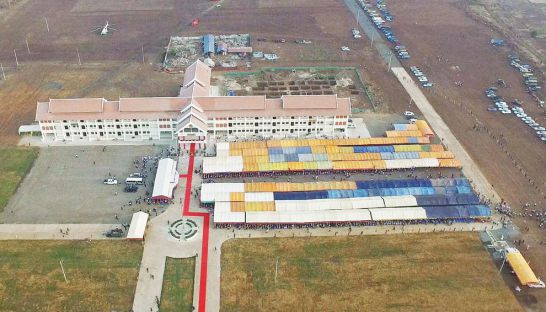As new province takes shape, villagers call for unpaid compensation
As new province takes shape, villagers call for unpaid compensation
In the thinly settled remote Sralob commune, near dense teak forests, the construction of administration office buildings for the newly-formed Tboung Khmum province has reached 60 per cent. Less than a kilometer away sits the recently inaugurated Heng Samrin Tboung Khmum University, a massive facility that, during the ribbon cutting ceremony earlier this month by the Prime Minister, heralded a call to improve education outside of the capital. But for the local villagers who gave up their land for the provincial office buildings nearby, they claim they have yet to be paid.

“The construction of the provincial administration hall and office buildings for various departments has progressed from 55 percent to 60 percent and two of the six dormitories for public officials are completed as well,” Tiang Narith, director of Tboung Khmum Provincial Hall, said earlier this week.
While the construction of paved roads along with Tboung Khmum’s new administration centre is only part of phase one of the development, it is expected to finish by the first half of 2018, said Narith.
Tboung Khmum province – which covers more than 5,000 square kilometers, with a population of more than 750,000 – split from Kampong Cham in December 2013, a few months after the ruling Cambodian People’s Party lost its undisputed dominance to the opposition Cambodia National Rescue Party during the national elections in 2013. While some called it a possible political manoeuver to divide up parliamentary seats, others said that the decision could have been more moot – a broader strategy of decentralisation.
Regardless, while a new province demands new facilities for government officials, the development was immediately confronted with a shortage of infrastructure.
More than lacking administrative offices for its officials in the new provincial centre, it is also hard to reach by officials in the first place.
The current provincial administration centre is located in Ponnhea Kraek district, 15 kilometres away from Sralob commune while the next biggest city, Soung City – where many officials live – is 20 kilometres away.
“Our officials have nowhere to stay because their houses are far from here. Additionally, we are running temporary offices by renting villagers’ houses. When the provincial hall building is completed, we will have office space for our public officials,” Narith continued. The six dormitories will be used by officials who cannot commute to work every day.
Kim Heang, president of Cambodian Valuers and Estate Agents Association (CVEA), expressed his curiosity on the chosen location and suspected that the decision for the new provincial center may have been influenced more by wealthy landowners in the area, rather than it being a functional location.
“The development project should be undertaken in Ponnhea Kraek district because it’s a town and can be expanded. It will be difficult for public officials to travel to the new location,” Heang said.
As to why Sralob was chosen, Narith explained that it was a decision handed down by the Ministry of Economy and Finance.
“A group from the Ministry of Economy and Finance examined the area and decided on the teak forest area, primarily because it was mostly state land and the development would avoid land disputes that have happened in other provinces. [And] geographically, the location is the province’s centre.”
He added that the ministry’s delegation designed a specific master plan as part of a long-term vision to develop a new provincial city.
The new city – covering more than 3,000 hectares – is divided into different zones for administrative offices, businesses, industrial spaces, universities and public parks.
According to Narith, the Tboung Khmum’s administrative building project was granted to Ly Chhuong Construction Co. Ltd., the same local construction company that built the Kingdom’s National Assembly nearly 10 years ago.
While the cost of developing a new city, as well as the proposed amount invested into such an ambitious development, remain unknown, local officials maintained that the development had been solely planned through a collaboration between the Ministry of Economy and Finance and Ly Chhuong Construction Co. Ltd.
“I do not have an exact figure, but the Ministry of Economy and Finance and Ly Chhuong Construction have prepared an amount for each phase,” Narith said, adding that budget also has a certain amount allocated for villagers’ compensation.
While Prach Chan, Tbong Khmum’s provincial governor, previously told Post Property that all land disputes had been settled eight months ago, Neang Savath, Tboung Khmum’s provincial coordinator for local Adhoc rights group, said that some 80 villagers who gave up their land for development have not yet seen a cent in compensation.
According to Savath,the villagers were coaxed into giving up their land as the provincial authority promised immediate compensation right after a verbal agreement was made. But now, many have grown impatient as they see the development around them.
Huot Don gave up three hectares for the provincial development in May of last year.
“My farmland was already cleared, but I have not received compensation. Previously, compensation [to others] was made before the land was cleared, but I have not seen anything yet,” he said.
Adhoc’s Savath said that the villagers need their agreed-upon compensation so that they can buy new land and plant crops. He noted that while compensation was agreed upon strictly on a verbal agreement, “the provincial authority has made promises over and over again.”
However, Narith said that while compensation has already been recorded by the Ministry of Economy and Finance, “we are still waiting for the working group to submit the money request to the government to compensate the affected villagers.”
Called on Wednesday morning, the spokesman for the Ministry of Economy and Finance said he was in a meeting all day long and could not comment, while Ly Chhuong Construction could not be reached.













